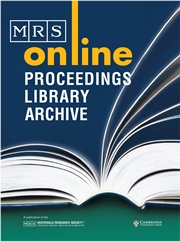No CrossRef data available.
Article contents
Defect Network in Superconducting Ceramic Oxides Studied by Neutron and Proton Irradiation
Published online by Cambridge University Press: 26 February 2011
Abstract
This paper investigates both transport properties and nature of superconductivity breakdown or, conversely, enhancement in oxide ceramics, due to radiation-induced defects.
Low-fluence neutrons (≈107 n cm-2 at 3 MeV) can sensitively damage the samples, giving experimental evidence that the breakdown of coherent percolating paths produces decoupled domains. A set of preliminary measurements shows that high-fluence proton implantation can either damage or enhance critical current density in a currently non controllable way. In both cases strongly damaged or enhanced superconducting paths short-circuit the unaffected bulk network.
- Type
- Research Article
- Information
- Copyright
- Copyright © Materials Research Society 1991


